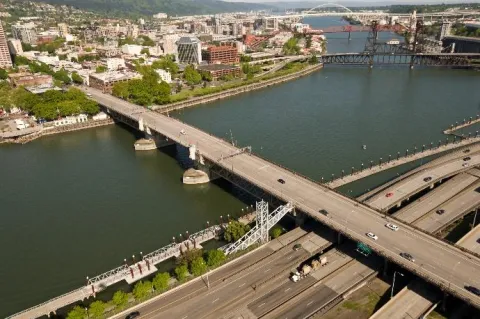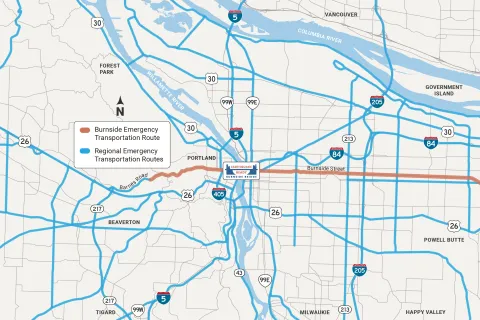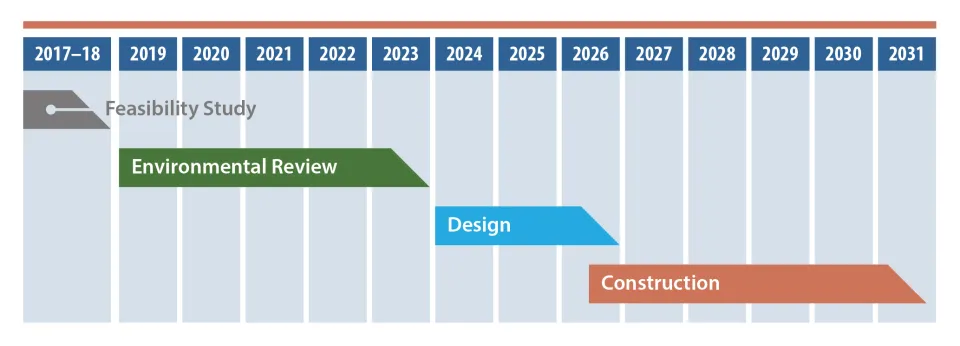
Right now, none of downtown Portland’s Willamette River vehicular bridges will be immediately usable after a major earthquake. Multnomah County is leading an effort to replace the current Burnside Bridge with one that can withstand a Cascadia Subduction Zone Earthquake. It’s one of the largest earthquake resilience projects in Oregon.
The Burnside Bridge is located on a regionally established lifeline route and it's critical that the bridge is still standing after a major earthquake. A new Burnside Bridge will provide a critical lifeline route for first responders to get to those who need help after a major earthquake. It will be our beacon for safety, emergency response and recovery. It will also provide safer, more accessible multimodal transportation facilities in the heart of Portland, serving our community for the next 100 years.
Project Area
The Burnside Bridge crosses over the Willamette River in downtown Portland, Oregon’s largest city. It is also located along a regionally designated Emergency Transportation Route, as established by Metro’s Regional Emergency Management Group. The bridge crosses important transportation infrastructure in Portland, including the I-5 mainline and I-84 ramps, Union Pacific Railroad (UPRR) freight rail tracks, TriMet MAX light rail tracks, Waterfront Park, Naito Parkway, and the Eastbank Esplanade. Portland Fire and Rescue Station #1 is less than half a mile from the bridge and will depend on its immediate use following a major earthquake.

Background
The Earthquake Ready Burnside Bridge project began in 2016 with a Feasibility Study Phase (2017-2019) that lasted two years. During this phase, the project team studied more than 100 options including tunnels, ferries, double-deck bridges and other bridge options. From that study, four bridge alternatives were recommended for further evaluation in the Environmental Review Phase (2019-2023). After a robust environmental analysis of the four alternatives, and with input from the community, agencies and regulatory bodies, the Replacement Long-Span was selected as the Preferred Alternative.
Project at a Glance
- The project will provide the first seismically resilient crossing in downtown Portland that will be immediately usable after a major earthquake. The new Burnside Bridge will support emergency relief efforts, reunite families, connect people to critical services and serve an instrumental role in a faster, more efficient economic recovery for the region and state.
- The new bridge will have 17-foot-wide bicycle and pedestrian paths on each side of the bridge, with crash-worthy barriers separating motorized vehicles from active transportation users. This barrier will significantly increase safety for pedestrians, bicyclists and people with disabilities.
- There will be improved transit facilities, including upgrades to nearby bus stops and retention of the eastbound bus-only lane. The new bridge will also be built to accommodate a future Portland Streetcar line.
- New or improved ADA-compliant sidewalks will connect to nearby transit facilities, creating safer, more comfortable access for people with disabilities.
- By reducing the number of vehicular lanes from five to four, the new bridge will help reduce greenhouse gas emissions. It will improve active transportation and transit options, supporting a healthier and more sustainable lifestyle.
- The project will create thousands of jobs and pump $545 million into the local, state and regional economy. 30% of that workforce will be made up of minorities, women, emerging small business enterprises and apprenticeships.
- The project will use locally sourced materials. Approximately 50% of materials will come from within the state or region.
Design Phase
The project is currently in the Design Phase. This is a detailed process that includes looking at bridge form, architectural and aesthetic features, mechanical and structural components, constructability issues, costs and long-term maintenance needs. The project team will work closely with engineers, architects, contractors, agencies and regulatory bodies during this phase.
The Design Phase also includes robust public outreach. In summer 2024, the project launched an online survey, which asked for community input on the future look of the new Burnside Bridge. That community feedback helped provide important data for the project’s Community Design Advisory Group, which ultimately provided a bridge type recommendation to the project and Multnomah County Board of Commissioners.
At its board meeting Thursday, Sept. 12, 2024 the Board unanimously adopted a resolution to move forward with the inverted Y design option for the future look of the new Burnside Bridge.
Schedule

Questions or Comments?
Please use this form to contact the project team with any questions or comments or to sign up for project updates.
